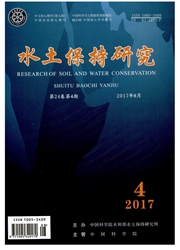

 中文摘要:
中文摘要:
叶绿素作为衡量湖泊富营养化的重要指标,利用遥感技术对其进行实时动态监测具有重要意义。以太湖为例,通过对水体实测光谱和水质采样数据的分析,建立了光谱反射率比值与叶绿素a浓度的回归模型。结果显示,700nm附近波段与625nm附近波段所构建的比值模型R^2最高,710nm以后波段与其他可见光波段所构建的比值模型的R^2会随可见光波长的增大而逐渐下降。在高光谱遥感估算模型的基础上,应用同步MODIS卫星遥感数据进行了太湖叶绿素a浓度的空间分布反演,并基于MODIS绿度指数建立了太湖藻华水体信息提取模型,从叶绿素a浓度估算和藻华信息提取两个方面实现了太湖藻类空间分布特征的定量反演,为太湖等大型内陆水体藻类的实时定量遥感监测提供了新的研究思路。
 英文摘要:
英文摘要:
Chlorophyll is a very important indictor for the eutrophication status of lake water body. Using remotely sensed data to achieve real-time dynamic monitoring of the spatial distribution of chlorophyll has great importance. This paper aims to find the best band for the hyperspectral ratio model of chlorophyll-a, and take advantage of this model to implement remote sensing retrieval of algae in Taihu Lake. By the analysis of the spectral reflectance and water quality sampling data of the surface water body, the regression model between the ratio of reflectance and chlorophyll-a was built, and it was showed that the ratio model between the wavelengths around 700 and 625 nm had a relatively high coefficient value of determination (R^2), while the ratio model constructed with 710 nm and visible wavelengths showed a descended R^2 following with the increment of the visible wavelengths. Combined with in-situ water samplings analysis and spectral reflectance measurement, the results showed that it's possible to retrieve algae water body using the MODIS green index (GI). The spatial distributions of chlorophyll-a and algae in Taihu Lake were extracted successfully using MODIS data with the algorithm developed in this paper.
 同期刊论文项目
同期刊论文项目
 同项目期刊论文
同项目期刊论文
 Detection of acid rain stress effect on plant using hyperspectral data in Three Gorges region, China
Detection of acid rain stress effect on plant using hyperspectral data in Three Gorges region, China Evaluating the spatiotemporal variations of water budgetacross China over 1951–2006 using IBIS model
Evaluating the spatiotemporal variations of water budgetacross China over 1951–2006 using IBIS model 期刊信息
期刊信息
